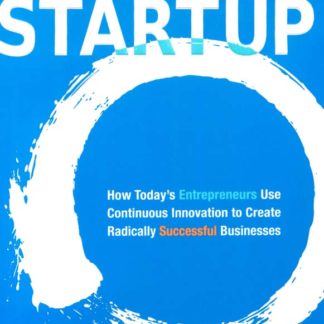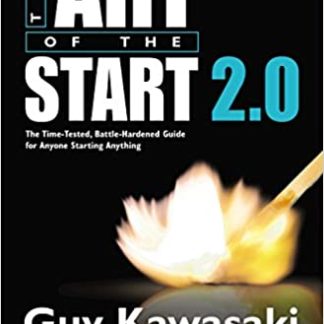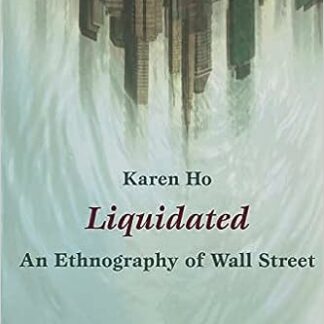Description
Financial collapses—whether of the junk bond market, the Internet bubble, or the highly leveraged housing market—are often explained as the inevitable result of market cycles: What goes up must come down. In Liquidated, Karen Ho punctures the aura of the abstract, all-powerful market to show how financial markets, and particularly booms and busts, are constructed. Through an in-depth investigation into the everyday experiences and ideologies of Wall Street investment bankers, Ho describes how a financially dominant but highly unstable market system is understood, justified, and produced through the restructuring of corporations and the larger economy. Ho, who worked at an investment bank herself, argues that bankers’ approaches to financial markets and corporate America are inseparable from the structures and strategies of their workplaces. Her ethnographic analysis of those workplaces is filled with the voices of stressed first-year associates, overworked and alienated analysts, undergraduates eager to be hired, and seasoned managing directors. Recruited from elite universities as “the best and the brightest,” investment bankers are socialized into a world of high risk and high reward. They are paid handsomely, with the understanding that they may be let go at any time. Their workplace culture and networks of privilege create the perception that job insecurity builds character, and employee liquidity results in smart, efficient business. Based on this culture of liquidity and compensation practices tied to profligate deal-making, Wall Street investment bankers reshape corporate America in their own image. Their mission is the creation of shareholder value, but Ho demonstrates that their practices and assumptions often produce crises instead. By connecting the values and actions of investment bankers to the construction of markets and the restructuring of U.S. corporations, Liquidated reveals the particular culture of Wall Street often obscured by triumphalist readings of capitalist globalization. Read more
From Publishers Weekly The timely question, What caused the current global financial crisis? provokes answers usually aimed at the level of institutions and the more abstract market logic. Ho’s refreshing ethnography of the daily lives of Wall Street investment bankers takes another tack and outlines a web of practices, beliefs and structures that may be vital to understanding what keeps the market system in place despite built-in instabilities. Ho, a former business analyst and now an associate professor of anthropology at the University of Minnesota, unpacks constant downsizing, high risk/high reward job liquidity, shortsighted compensation structures, prestige and the ruse of shareholder value. Her keen eye for the significance of space illuminates workplace narratives, e.g., segregating staff by floor, function and prestige; constant and lavish recruiting events at Princeton and Harvard; and anticlimactically tawdry office space for most workers. The author exposes how elite undergraduates are immersed in a culture promoting finance as the only legitimate job, how educational pedigrees reinforce the financial world’s self-image—while the actual jobs remain rigidly hierarchical (stratifying women, people of color and non–Ivy League graduates), highly unstable and isolating, encouraging a culture in which making money is the only value. (Aug.) Copyright © Reed Business Information, a division of Reed Elsevier Inc. All rights reserved. Review “Liquidated is a must-read book for anyone interested in how legions of recruits from Ivy League colleges come to espouse and enact the twisted bundle of class interests and market ideology that constitutes neoliberal capitalism.”―Kathryn Dudley, American Studies“Liquidated is an interesting description of many of the practices and orientations that exist in large investment banks, one that confirms what the reader may suspect: that these institutions are forcing-grounds for the sort of hubris and invulnerability that goes with the phrase ‘Masters of the Universe’, the incomprehensible money that sales staff receive, and the idea that they are ‘doing God’s work’. It also, however, indicates the reverse of the strength of the social studies of finance. Liquidated may help explain why those in investment banks think and operate in the ways that they do.”―James G. Carrier, Journal of the Royal Anthropological Institute“[A] unique portrait of the industry that asks pertinent questions about constant change, job insecurity, and the banker’s identity. . . . Liquidated: An Ethnography of Wall Street asks many questions that those who work in the investment field should ask themselves. . . . Although many in the financial industry will not agree with Ho’s hypotheses and conclusions, they will be challenged by the questions she raises and enthralled by the body of fieldwork she presents.”―Janet J. Mangano, Financial Analysts Journal“Ho’s refreshing ethnography of the daily lives of Wall Street investment bankers . . . outlines a web of practices, beliefs and structures that may be vital to understanding what keeps the market system in place despite built-in instabilities.”―Publishers Weekly“Ho’s study shows the intense competitiveness that is instilled in these primarily Ivy League recruits even before they are finished with their Bachelor’s degrees. And she examines the myth that stockowners and companies are best served by maximizing shareholder profits. If anything, this book gives faces to the people who work in that abstract entity called Wall Street that seems to affect our world so much of late. I highly recommend it, especially if you have no idea how the world of high finance operates.”―James Franco, Huffington Post“The book contains many wonderful insights, and is a veritable mine of quotations from Wall Street participants. . . . The book is, moreover, extremely well written throughout . . . . [A]n informed and informative text.”―Brett Christophers, Environment and Planning A“[E]ngaging and hard to put down. . . Karen Ho’s book is a must-read for anyone contemplating joining one of the major global banks. . . . Actually, even faculty of our elite schools are starting to question why so many of their graduates end up in finance. Karen Ho’s book should be required reading for students and faculty at these schools.”―Ben Lorica, Quant Network“After several decades when anthropologists at last overcame their inhibitions concerning the study of money, Karen Ho’s book . . . seems to mark a coming of age for the contemporary discipline. . . . The intelligence of its author shines through Liquidated. . . . I found it rewarding to read and reflect on, a landmark in the burgeoning anthropology of money.”―Keith Hart, American Ethnologist“Although written for a mostly academic audience, the book becomes easily digestible because of the summaries Ho adds in each section. She connects well the main theme throughout any areas of the book. Ho’s views should not be considered ‘anti-Wall Street’ but viewed as an analysis of Wall Street’s effect on the American community and the financial markets. This book should be read by Wall Street investment bankers and corporate managers to better understand the social values and responsibilities of corporations and the role that they play in the American community.”―Linda Kee-Koa, International Examiner“Karen Ho has picked an excellent time to publish her fascinating new study . . . of Wall Street banks. . . . As field-sites go, Wall Street is not classic anthropological territory: ethnographers typically work in remote, third-world societies. . . . Ho nevertheless embarked on her study in classic anthropological manner: by blending into the background, listening intently, in a non-judgmental way – and then trying to join up the dots to get a ‘holistic’ picture of how the culture works. That patient ethnographic analysis has produced a fascinating portrait that will be refreshingly novel to most bankers.”―Gillian Tett, Financial Times“Karen Ho is my hero. . . . Her ethnography of investment bankers in the late 1990s, Liquidated, depicts the bravado, callousness, and contradictions that are the hallmarks of investment banking culture.”―Mitchel Y. Abolafia, American Journal of Sociology“The book’s great strength lies in Ho’s careful observation of the means by which people succeed or fail on Wall Street, as she punctures many of the assumptions about how markets work.”―Keir Martin, TLS Review “What could be more timely than this fascinating and highly readable investigation of the culture of Wall Street? With Liquidated, Karen Ho takes us into the workaday world of investment banking before the crisis, showing us the roots of the risk-taking that drew lavish compensation packages and brought the world financial system to the brink of collapse. A significant contribution both to the anthropological and wider social scientific literature on financial markets and globalization, as well as to the urgent public debate over the power of financial institutions in contemporary American society.” — Bill Maurer, author of ― Pious Property: Islamic Mortgages in the United States From the Publisher “We’re pretty familiar with the economic rationale for the regime of cost-cutting and downsizing throughout corporate America in recent decades. But Karen Ho’s research greatly enriches our understanding of how Wall Street’s own peculiar culture of transient relationships and relentless competition has contributed to the shareholder revolution. And, along the way, her interviews and fieldwork offer a very revealing picture of the mind of Wall Street. A fascinating and important book.”–Doug Henwood, editor of the Left Business Observer and author of Wall Street: How It Works and For Whom “Liquidated is what many of us have been waiting for: a serious ethnographic consideration of finance capital. Using the best kinds of cultural and social analysis, Karen Ho gets inside Wall Street assumptions, turning them around to upend each other.”–Anna Lowenhaupt Tsing, author of Friction: An Ethnography of Global Connection From the Back Cover “What could be more timely than this fascinating and highly readable investigation of the culture of Wall Street? With “Liquidated,” Karen Ho takes us into the workaday world of investment banking before the crisis, showing us the roots of the risk-taking that drew lavish compensation packages and brought the world financial system to the brink of collapse. A significant contribution both to the anthropological and wider social scientific literature on financial markets and globalization, as well as to the urgent public debate over the power of financial institutions in contemporary American society.”–Bill Maurer, author of “Pious Property: Islamic Mortgages in the United States” About the Author Karen Ho is Associate Professor of Anthropology, University of Minnesota. Excerpt. © Reprinted by permission. All rights reserved. LiquidatedAN ETHNOGRAPHY OF WALL STREETBy KAREN HODuke University PressCopyright © 2009 Duke University PressAll right reserved.ISBN: 978-0-8223-4599-2Contentsacknowledgments………………………………………………………………………………………………………ixIntroduction: Anthropology Goes to Wall Street…………………………………………………………………………..11 Biographies of Hegemony: The Culture of Smartness and the Recruitment and Construction of Investment Bankers…………………392 Wall Street’s Orientation: Exploitation, Empowerment, and the Politics of Hard Work……………………………………….733 Wall Street Historiographies and the Shareholder Value Revolution……………………………………………………….1224 The Neoclassical Roots and Origin Narratives of Shareholder Value……………………………………………………….1695 Downsizers Downsized: Job Insecurity and Investment Banking Corporate Culture…………………………………………….2136 Liquid Lives, Compensation Schemes, and the Making of (Unsustainable) Financial Markets……………………………………2497 Leveraging Dominance and Crises through the Global…………………………………………………………………….294notes……………………………………………………………………………………………………………….325references…………………………………………………………………………………………………………..353index……………………………………………………………………………………………………………….369Chapter One Biographies of Hegemony: The Culture of Smartness and the Recruitment and Construction of Investment Bankers When I began to conduct fieldwork in 1998 and 1999, delving into the network of contacts, coworkers, and friends I developed at Stanford, Princeton, and Bankers Trust (BT), it struck me how often my informants ranked and distinguished themselves according to their “smartness.” The term seemed fundamental to the Wall Street lexicon. My informants proclaimed that the smartest people in the world came to work there; Wall Street, in their view, had created probably the most elite work-society ever to be assembled on the globe. Almost all the front-office workers that I encountered emphasized how smart their coworkers were, how “deep the talent” was at their particular bank, how if one just hired “the smartest people,” then everything else fell into place. Chris Logan and Nicolas Bern, recent Princeton graduates working at BT and Merrill Lynch respectively, explained that from their relatively fresh perspective, what was most culturally unique about Wall Street was the experience of being surrounded by, as Bern put it, the “smartest and most ambitious people.” Logan added that the three qualities of success on Wall Street are to be “smart, hardworking, and aggressive. Everything else is considered tangential.” According to Kate Miller, a Spelman College graduate and former analyst at Morgan Stanley, interviewees are typically told they will be working with “the brightest people in the world. These are the greatest minds of the century.” Such sentiments were not confined to eager young analysts or investment banking representatives talking up their industry to overawed recruits. Julio Muoz, who received his MBA from Harvard and was an associate in investment banking at Donaldson, Lufkin and Jenrette (DLJ), a prestigious boutique investment bank which has since been bought out by Credit Suisse First Boston (CSFB), claimed that the most distinguishing features of investment banks are their smartness and exclusivity: People are really smart. They really don’t hire any-the hiring standards are pretty good. That’s one thing they really focused on doing, and that differentiates investment banking from other working environments in that they really do target the experienced individuals with good academic background…. [This] really brings to the investment banks a very elite society-somebody in society that had the means to study in X universities. If you really narrowed down the universities where the investment banks recruit, your number probably will not exceed fifteen to twenty universities. Similarly, John Carlton, a senior managing director at BT who had worked at multiple investment banks such as Kidder Peabody and CSFB, stated that the key characteristics of Wall Street investment bankers are their smartness, aggressiveness, and self-confidence: “There is always a premium on having smart people … so, it is highly competitive. What happens is that a lot of people say, ‘Look, some of the best and brightest people are going to Wall Street. I’m pretty smart myself; I should go [there] as well. And, by the way, I get paid very well.'” Remarking on how hedge funds attract the most brilliant minds from investment banks, Robert Hopkins, a vice president of mergers and acquisitions at Lehman Brothers, exclaimed, “We are talking about the smartest people in the world. We are! They are the smartest people in the world. If you [the average investor or the average corporation] don’t know anything, why wouldn’t you invest with the smartest people in the world? They must know what they are doing.” The “culture of smartness” is central to understanding Wall Street’s financial agency, how investment bankers are personally and institutionally empowered to enact their worldviews, export their practices, and serve as models for far-reaching socioeconomic change. On Wall Street, “smartness” means much more than individual intelligence; it conveys a naturalized and generic sense of “impressiveness,” of elite, pinnacle status and expertise, which is used to signify, even prove, investment bankers’ worthiness as advisors to corporate America and leaders of the global financial markets. To be considered “smart” on Wall Street is to be implicated in a web of situated practices and ideologies, coproduced through the interactions of multiple institutions, processes, and American culture at large, which confer authority and legitimacy on high finance and contribute to the sector’s vast influence. The culture of smartness is not simply a quality of Wall Street, but a currency, a driving force productive of both profit accumulation and global prowess. The key criterion of smartness is an ability to “wow” the clients-generally speaking, the top executives of Fortune 500 companies. In this sense, although technical skill and business savvy also help to constitute smartness on Wall Street, they are often considered secondary, learnable “on the job.” “The best,” “the greatest,” and “the brightest” minds in the world are sorted and recognized through a credentialing process that is crucially bolstered by image and performance. In other words, smartness must be represented and reinforced by a specific appearance and bodily technique that dominantly signals that impressiveness; not surprisingly, such characteristics as being impeccably and smartly dressed, dashing appearance, mental and physical quickness, aggressiveness, and vigor reference the default upper-classness, maleness, whiteness, and heteronormativity of ideal investment bankers. Though here I focus mainly on the specific elitism that is the key valence of smartness, in the next chapter, I further analyze “the total package” through which smartness is recognized and delivered. What allows investment bankers to claim smartness, what defines and legitimates them as smart in the first place, and what particular kind of smartness is being deployed? Where these questions become especially clear is during the process of investment banker identity and social formation: the recruiting, training, and orientation of freshly minted college graduates and MBAs, their initiation into the world of Wall Street. Here it is possible to discern, in starkest relief, Wall Street’s cultural values in action, particularly the construction and maintenance of the hegemonic elitism that produces “expert” knowledge of financial markets. Through the continual praxis of recruitment and orientation, the Street enacts and regenerates the very foundations of its legitimacy. Through the process of recruitment and orientation, investment banks define their notion of both what it takes and what it means to be a successful subject in an age of global capital. To play the role of “master of the universe” requires not only especially strong doses of self-confidence and institutional legitimation, but also a particular set of beliefs regarding Wall Street’s role in the world and one’s own role on Wall Street. Investment bankers, trained to view financial markets and corporate America through particular, highly ideological lenses, are also imbued with a sense of their own personal exemplariness as agents of and models for socioeconomic change-a sense that must be embodied, believed in, and continually “pumped up.” In approaching the question of how investment bankers become empowered to advise and influence the direction of corporations in the United States and globally vis vis their personal trajectories, qualities, connections, associations, and identities, I make the case for the importance of the biographical and the institutional in enacting global capitalist change. The building blocks of dominant capitalist practices are also personal and cultural; people’s experiences, their university and career tracking and choices, are constitutive of capitalist hegemony; and the financial is cultural through and through. In particular, I focus on the construction of “the smart investment banker”: a member of an extended “family” network of elite university alumni and a living symbol of know-how and global agency. Their impressiveness and financial influence are further cemented and proven by surviving brutally intense hard work and an insecure job environment, which in turn allows them to internalize the merit of their analyses and recommendations. Through the institutional culture of Wall Street broadly conceived-where job experiences and workplace incentives map onto elite biographies-investment bankers not only imbibe a particular ideology of shareholder value and spread it across corporate America, but they are also pushed to refashion and reconstruct the working lives of millions in the image of their own. By investigating investment bankers, as individuals and as collective agents of change, I do not assume a priori that “the market” always already exercises power, but rather that the particular biographies, experiences, and practices of investment bankers, who are both empowered and constrained by their cultural and institutional locations, create social change and financial hegemony on a daily basis. Just as “it is through the ‘small stories’ that one can begin to unravel and challenge homogenizing discourses embedded within concepts such as globalization, ‘the’ market, and ‘the’ state,” it is possible to decenter the market as an abstract agent and powerful force by demonstrating that it is only through the small and the everyday that we can understand the creation of hegemony in all its particularity and contextuality. Otherwise, we risk privileging, homogenizing, or taking for granted the metanarratives of the market, the big stories (Crossa 2005, 29; S. Smith 2005). Recruitment I first entered the cultural world of investment banks through the herculean recruiting efforts that Wall Street undertakes at the most elite universities. Despite my own ambivalence and feelings of mystification about Wall Street as an anthropology graduate student, this direct link-the pipeline between Princeton University and investment banks-enabled my very access to each step of the recruiting process, not to mention the field site itself. Wall Street, in a sense, came to me. Although I hardly recognized it at the time, Wall Street’s ubiquity on campus, as well as the intensity of undergraduate interest in investment banking, meant that merely being a student at Princeton allowed, in a sense, automatic participant observation of this world. After fieldwork, I returned to Princeton to write the dissertation, thinking I would be getting away from Wall Street, retreating to an ivory-tower refuge in order to do some serious thinking and writing. Instead, it was more like reentering the belly of the beast. I was a graduate advisor at an undergraduate resident hall. Two weeks into the job, taking a walk after dinner I crossed paths with an undergraduate crowd (two of whom lived in my residence hall) headed toward Nassau Hall. Before I knew it, they had steered me into a Merrill Lynch presentation! The masses of students converging on these recruitment presentations and information sessions are akin to the campus traffic generated by the gatherings and dispersals of concert crowds. Already a veteran of the actual recruitment process back in 1996, now, almost four years later, after campus recruiting had even further intensified as a result of the bull market, I found myself participating in countless dining hall discussions about investment banking, attending still more presentations, and reading endless investment banking advertisements, updates, news, and opinion pieces in the pages of the Daily Princetonian. In 2000, I also had access on a regular basis to many of Wall Street’s cultural representations and practices at Harvard University because my younger sister was an undergraduate there at the time. She introduced me to friends going through the recruiting process and kept me continually updated on how many of her acquaintances had suddenly, in their senior year, found their true calling as Wall Street investment bankers or management consultants. As many of my previous investment banking informants were also Harvard graduates, I have been able to make detailed observations of Wall Street’s interactions with two elite universities. More so than even the other Ivy League schools, Harvard and Princeton are the “prime recruiting ground for all of the most prestigious Wall Street, management consulting and other types of firms that offer the most sought after jobs…. The Princeton badge is a powerful currency that buys access” (Karseras 2006). As many of my informants have elaborated, “If you go to Harvard, Yale, or Princeton, there are really only two career fields presented: banking and consulting” (Duboff 2005). This shocking narrowness was verified throughout my time at Princeton and on Wall Street: I found not only that most bankers came from a few elite institutions, but also that most undergraduate and even many graduate students assumed that the only “suitable” destinations for life after Princeton-the only sectors offering a truly “Princeton-like job”-were, first, investment banking, and second, management consulting. With its extensive alumni network and juggernaut recruitment machine, Wall Street is the “de facto home away from Princeton for recent graduates, many of whom continue living together even as they take on new responsibilities and lifestyles” (Hall 2005). As perhaps the most important feeder school to Wall Street, Princeton sends astounding numbers of recruits into financial services in general, and in particular investment banking. According to the Office of Career Services, 30 percent of the class of 2001, 37 percent of the class of 2003, and 40 percent of the class of 2005 and 2006 entered financial services after graduation (Chan 2001; Creed 2003; Easton 2006; Henn 2001). Whereas from 2000 to 2005, 470 Princeton students pursued law or medical degrees, “520 Princeton students-about 40 percent of Princeton students choosing full-time jobs directly after graduation-decided to work in the financial services sector,” amounting to the largest percentage in a single industry (Hall 2005). At Harvard University, which rivals Princeton as the primary producer of Wall Street recruits, investment banking (as well as management consulting) also provides the majority of jobs for its students upon graduation (Lerer 1997). According to Harvard’s Office of Career Services, in 2005, close to half of Harvard students go through “the recruiting process to vie for investment banking and consulting jobs” (Huber 2006). As Devon Peterson, an undergraduate writing for the Daily Princetonian, observed in 2002, “It’s been common knowledge that many of [Princeton’s] undergraduates join the financial realm every year, creating a kind of lighthearted, self-deprecating joke about Philosophy majors becoming I-bankers and once hopeful novelists heading to Wall Street” (Peterson 2002). How do so many undergraduates who enter these institutions without any prior knowledge of investment banking, who once aspired to become, say writers or teachers, “realize” by the time they graduate that they have always wanted to go to Wall Street? How do these talented and well-connected students, with access to a wide range of possible futures, come to believe that investment banking is one of the only prestigious job options available post graduation? I argue that such changes in life courses and the attendant discursive transformations must be unpacked in order to understand the particular worldviews, cultural associations, and orientations the recruiting process demands and calls into being. The forces that push these college students toward investment banking are obviously multiple: the particular college environment, the strength of alumni and peer networks, the cultural linking of success and smartness with Wall Street, the hierarchical narrowing of career options and what constitutes prestige, to name a few. Perhaps the most self-evident reason for Wall Street’s recruiting monopoly is simply that its presence dominates campus life: recruiters visit the university virtually every week, even on weekends; they show up in the greatest numbers at career forums, panel discussions, and social events; their advertisements for information sessions, “meet and greets,” and free drinks and hors d’oeuvres dominate the campus newspapers daily; their company literature and application forms are easily accessible, either at campus locations or online. (Continues…) Excerpted from Liquidatedby KAREN HO Copyright © 2009 by Duke University Press. Excerpted by permission. All rights reserved. No part of this excerpt may be reproduced or reprinted without permission in writing from the publisher.Excerpts are provided by Dial-A-Book Inc. solely for the personal use of visitors to this web site. Read more
Refund and Returns Policy
Due to the nature of digital products, pdfTextbook does not offer refunds or returns for this product and all sales are final. please contact our customer service team before your purchase at [email protected].





Reviews
There are no reviews yet.